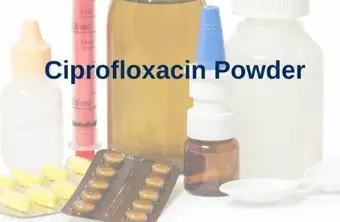Ciprofloxacin powder is a versatile form of the antibiotic medication used to treat various bacterial infections. Understanding the proper administration of this medication is crucial for its effectiveness and safety. This blog post will explore the correct methods of taking Ciprofloxacin powder, addressing common questions and providing essential guidelines for patients and healthcare providers.
What is the correct dosage for Ciprofloxacin Powder?
Determining the correct dosage of Ciprofloxacin powder is a critical aspect of its administration. The dosage can vary significantly depending on several factors, including the type and severity of the infection, the patient's age, weight, and overall health condition. It's essential to follow the prescribing physician's instructions carefully, as improper dosing can lead to reduced effectiveness or increased risk of side effects.
For adults, the typical dosage range for Ciprofloxacin powder can be anywhere from 250 mg to 750 mg, taken orally twice daily. However, this can change based on the specific infection being treated. For instance, urinary tract infections might require a lower dose, while more severe infections like respiratory tract infections or bone and joint infections may necessitate higher doses.

In pediatric patients, dosing is usually based on body weight, typically ranging from 10 to 20 mg per kilogram of body weight, divided into two daily doses. It's crucial to note that Ciprofloxacin is not recommended for routine use in children and adolescents due to potential effects on developing joints, and it should only be used in specific circumstances under close medical supervision.
For elderly patients or those with impaired kidney function, dosage adjustments may be necessary. In these cases, the doctor might prescribe a lower dose or extend the interval between doses to prevent the accumulation of the drug in the body.
When preparing Ciprofloxacin powder for oral suspension, it's vital to follow the reconstitution instructions provided with the medication carefully. This typically involves adding a specific amount of water to the powder and shaking well to ensure proper mixing. The resulting suspension should be used within 14 days and kept refrigerated between doses.
It's important to complete the entire course of treatment as prescribed, even if symptoms improve before the medication is finished. Stopping the antibiotic too soon can lead to the recurrence of infection and contribute to antibiotic resistance.
How long does it take for Ciprofloxacin Powder to work?
The time it takes for Ciprofloxacin powder to work can vary depending on several factors, including the type and severity of the infection, the patient's overall health, and how well they adhere to the prescribed regimen. Understanding the timeline for Ciprofloxacin's effectiveness is crucial for patients to maintain proper expectations and comply with the treatment plan.
In many cases, patients may begin to feel improvement in their symptoms within 24 to 48 hours after starting Ciprofloxacin treatment. This rapid initial response is due to Ciprofloxacin's mechanism of action, which involves inhibiting bacterial DNA replication, leading to a quick reduction in bacterial population. However, it's important to note that feeling better does not necessarily mean the infection is completely eradicated.
For urinary tract infections, which are commonly treated with Ciprofloxacin, patients often report a noticeable reduction in symptoms such as frequent urination and burning sensation within the first couple of days. However, the full course of treatment, typically lasting 3 to 7 days, must be completed to ensure the infection is fully cleared.

In the case of more severe or complicated infections, such as respiratory tract infections or skin and soft tissue infections, the full effect of Ciprofloxacin may take longer to manifest. Patients might not experience significant improvement for 3 to 5 days, and the entire course of treatment could last for 7 to 14 days or even longer in some cases.
It's crucial for patients to understand that even if they feel better, they should continue taking Ciprofloxacin for the entire prescribed duration. Stopping the medication prematurely can lead to a resurgence of the infection, potentially with antibiotic-resistant bacteria. This not only prolongs the illness but also complicates further treatment options.
Factors that can influence how quickly Ciprofloxacin works include the patient's immune system function, the presence of any underlying health conditions, and whether the bacteria causing the infection are fully susceptible to the antibiotic. In some cases, if a patient doesn't show improvement after a few days of treatment, their healthcare provider may need to reassess the diagnosis or consider alternative antibiotics.
Patients should be advised to contact their healthcare provider if they don't notice any improvement in their symptoms after 3 to 5 days of treatment, or if their condition worsens at any point during the treatment course. This allows for timely adjustment of the treatment plan if necessary.
Can Ciprofloxacin Powder be taken with food?
The question of whether Ciprofloxacin powder can be taken with food is an important consideration for patients and healthcare providers alike. The answer to this question can significantly impact the medication's effectiveness and the patient's comfort during treatment. Understanding the proper administration of Ciprofloxacin in relation to food intake is crucial for optimal therapeutic outcomes.
Generally, Ciprofloxacin powder, when reconstituted into an oral suspension, can be taken with or without food. However, there are some important considerations to keep in mind. Taking Ciprofloxacin with a meal can help reduce stomach upset, which is a common side effect of this medication. This can be particularly beneficial for patients who experience nausea or gastrointestinal discomfort when taking antibiotics.
That being said, it's important to note that certain foods and supplements can interfere with the absorption of Ciprofloxacin, potentially reducing its effectiveness. For instance, dairy products, calcium-fortified juices, and calcium supplements can significantly decrease the absorption of Ciprofloxacin. This is due to the formation of insoluble complexes between the antibiotic and calcium ions, which the body cannot absorb effectively.
To avoid this interaction, it's recommended to take Ciprofloxacin either 2 hours before or 6 hours after consuming dairy products or calcium-fortified foods. The same precaution applies to other mineral supplements, such as iron, zinc, or magnesium, which can also interfere with Ciprofloxacin absorption.
Similarly, products containing high levels of magnesium or aluminum, such as antacids or multivitamins, should be avoided within several hours of taking Ciprofloxacin. These substances can bind to the antibiotic in the digestive tract, preventing its proper absorption.
For patients who have difficulty swallowing pills or for pediatric use, Ciprofloxacin is available as a powder for oral suspension. When reconstituted, this liquid form can be easier to administer and may be more palatable, especially for children. The suspension can be taken with food to improve taste and reduce gastrointestinal side effects, but the same precautions regarding calcium and other minerals apply.
It's worth noting that while food generally doesn't significantly affect the absorption of Ciprofloxacin, maintaining consistent dosing in relation to meals can help ensure steady blood levels of the medication. If a patient chooses to take Ciprofloxacin with food, they should try to do so consistently throughout the course of treatment.
Patients should also be advised to drink plenty of water when taking Ciprofloxacin. Adequate hydration can help prevent the formation of crystals in the urine, a rare but potential side effect of this medication.
In conclusion, while Ciprofloxacin powder can be taken with food, patients should be aware of potential interactions with certain foods and supplements. Maintaining open communication with healthcare providers and carefully following dosing instructions can help ensure the safe and effective use of this important antibiotic.
If you are also interested in this product and want to know more product details, or want to know about other related products, please feel free to contact iceyqiang@aliyun.com.
References
- U.S. Food and Drug Administration. (2020). Ciprofloxacin Drug Label.
- Centers for Disease Control and Prevention. (2021). Antibiotic Use and Resistance.
- World Health Organization. (2020). Antimicrobial resistance.
- American Academy of Pediatrics. (2018). Red Book: 2018-2021 Report of the Committee on Infectious Diseases. Itasca, IL: American Academy of Pediatrics.
- Mandell, G. L., Bennett, J. E., & Dolin, R. (2019). Mandell, Douglas, and Bennett's Principles and Practice of Infectious Diseases. Philadelphia, PA: Elsevier.
- National Institute for Health and Care Excellence. (2018). Urinary tract infection (lower): antimicrobial prescribing.
- Bayer HealthCare Pharmaceuticals Inc. (2020). Cipro® (ciprofloxacin) Package Insert.
- Hooper, D. C., & Strahilevitz, J. (2019). Quinolones. In J. E. Bennett, R. Dolin, & M. J. Blaser (Eds.), Mandell, Douglas, and Bennett's Principles and Practice of Infectious Diseases (9th ed., pp. 419-439). Philadelphia, PA: Elsevier.
- European Medicines Agency. (2019). Quinolone- and fluoroquinolone-containing medicinal products.
- Chow, A. W., Benninger, M. S., Brook, I., Brozek, J. L., Goldstein, E. J., Hicks, L. A., ... & File, T. M. (2012). IDSA clinical practice guideline for acute bacterial rhinosinusitis in children and adults. Clinical Infectious Diseases, 54(8), e72-e112.

